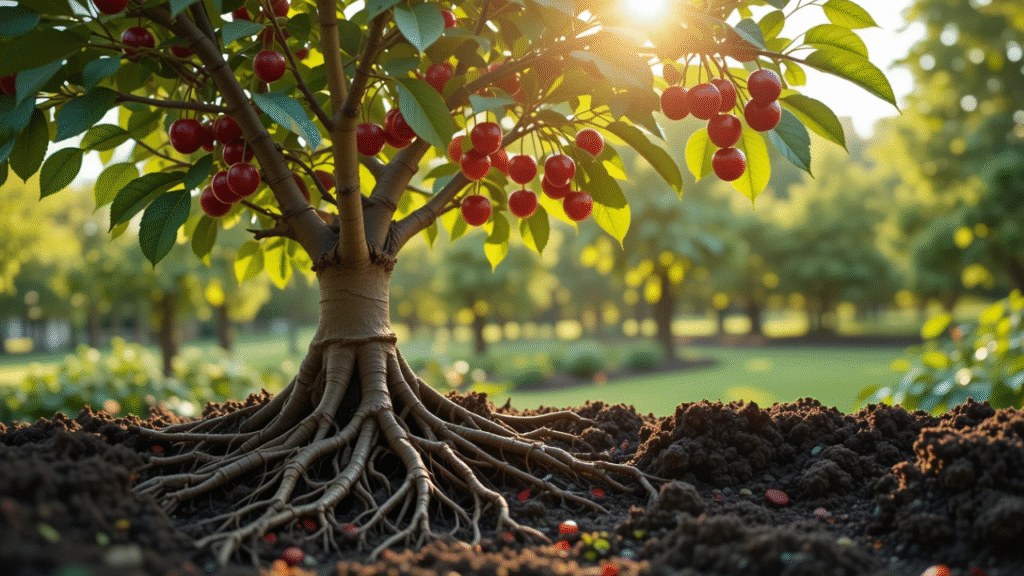
Cherry Tree Rootstock: Choosing the Best for Your Garden for Optimal Growth and Fruit Production
When it comes to growing a healthy and fruitful cherry tree, the secret often lies in the rootstock. 🌱 Whether you’re a seasoned gardener or just getting started, Cherry Tree Rootstock: Choosing the Best for Your Garden can make all the difference in your tree’s success. Rootstock plays a pivotal role in determining how your tree grows, how much fruit it yields, and even how resistant it is to diseases and pests. Selecting the right rootstock isn’t just about aesthetics—it’s about creating the best environment for your tree to thrive, producing bountiful, delicious cherries year after year. 🍒
In this guide, we’ll help you navigate the world of rootstocks, ensuring that you make an informed choice that leads to vibrant growth and maximum fruit production.
Table of Contents
Toggle🌳 What is Cherry Tree Rootstock? 🌳
Cherry tree rootstock is the base or root system onto which the cherry tree’s top (called the scion) is grafted. 🌳 Think of it as the foundation of your tree—it’s responsible for providing water, nutrients, and stability to the tree. But its impact doesn’t stop there! The rootstock also influences how the tree grows, how much fruit it produces, and even its resistance to pests and diseases. 🍒
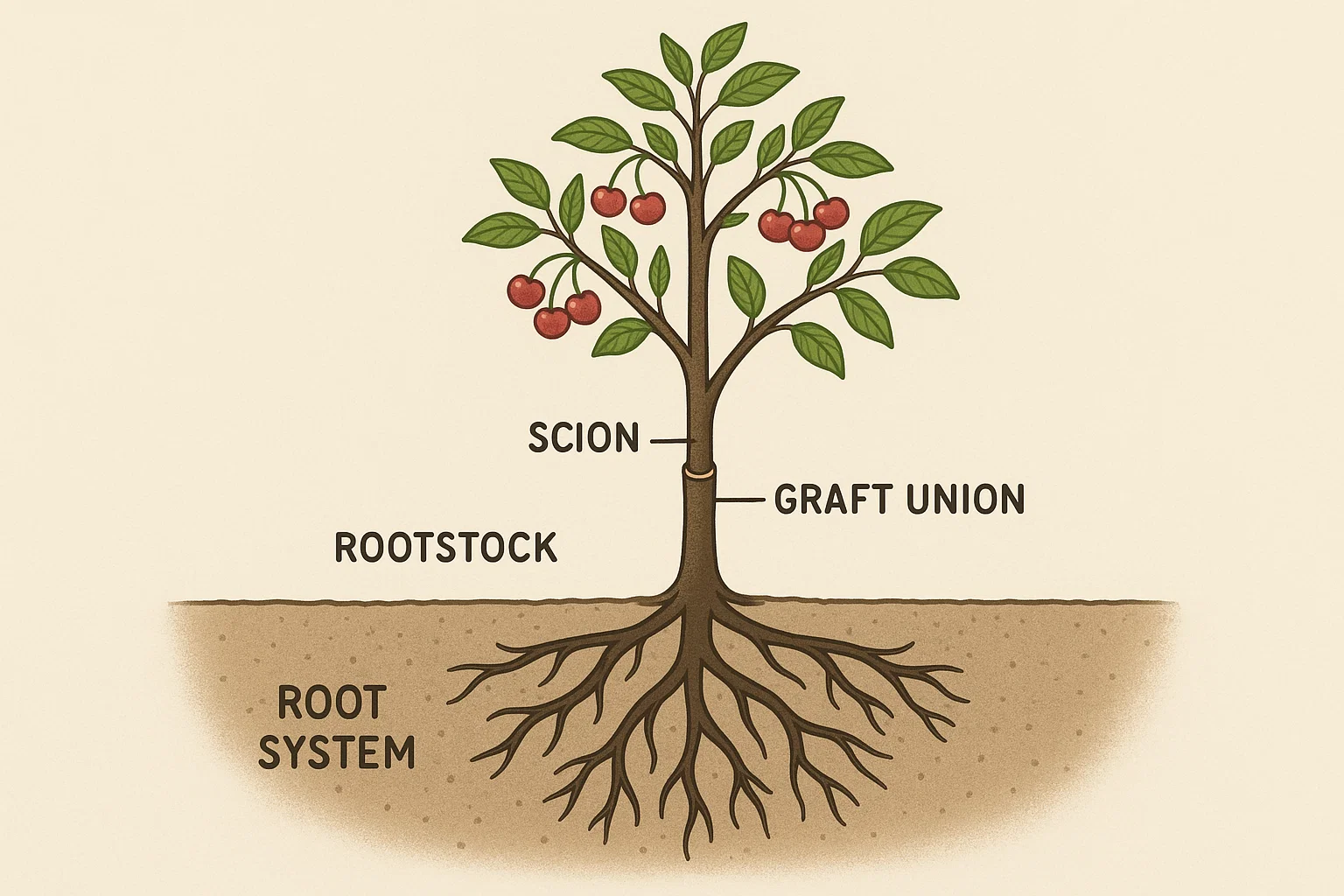
Rootstocks come in different varieties, each offering unique benefits. Some rootstocks lead to larger trees, while others result in smaller, more manageable ones. 🌱 Some are great for resisting diseases, while others help the tree thrive in specific soil types. The key to a healthy cherry tree is choosing the right rootstock to suit your garden’s needs.
In short, rootstock is not just a support system—it’s the starting point for your tree’s growth and productivity! 🌟
🌳 Common Types of Cherry Tree Rootstocks 🌳
Choosing the right cherry tree rootstock is crucial for optimal growth, fruit production, and overall tree health. Here are the most common types of rootstocks you’ll encounter:
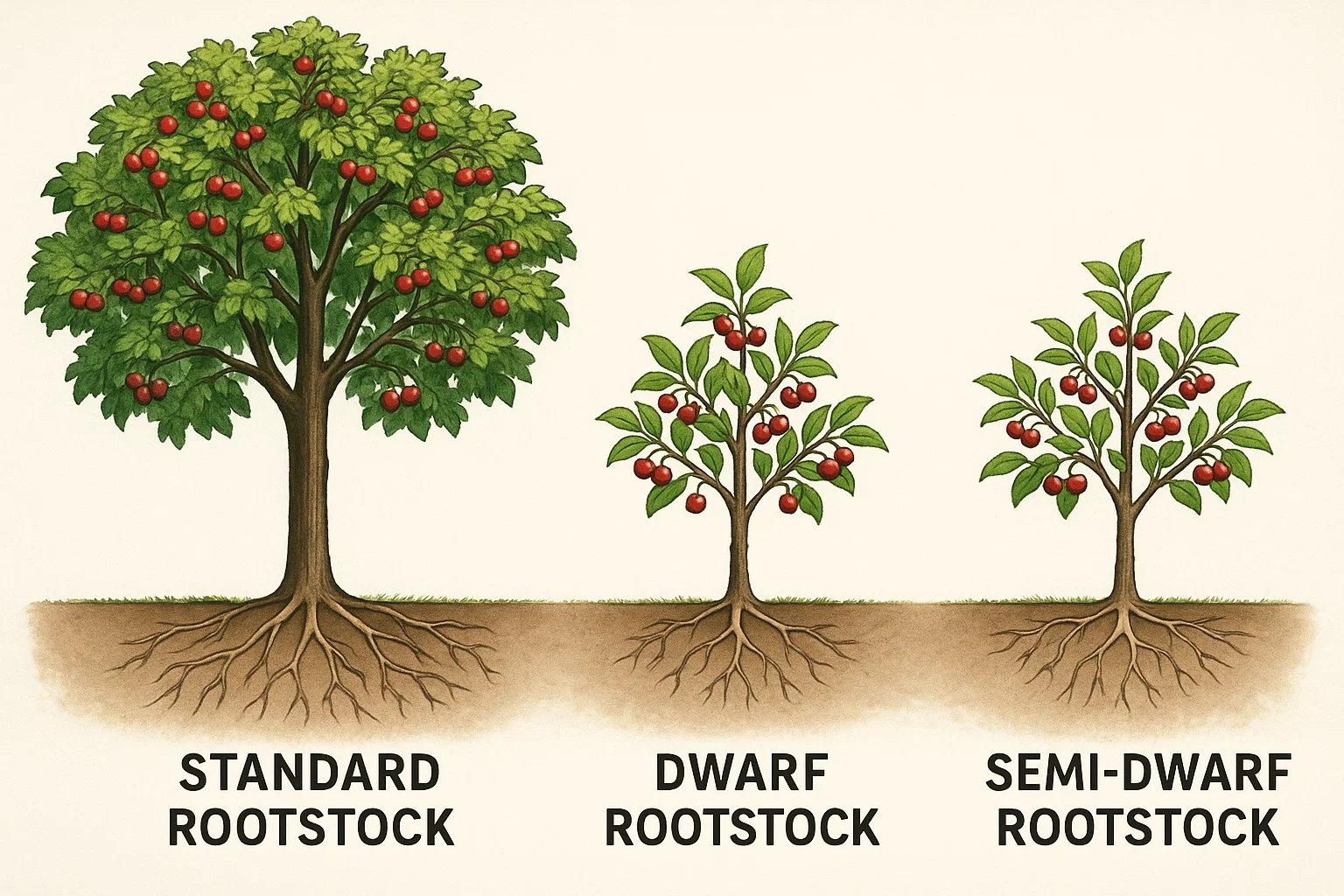
🌳 Standard Rootstocks 🌳
Standard rootstocks, like Mazzard, produce large trees that can grow up to 20 feet tall or more. 🌲 These trees have deep, strong root systems that make them very resilient in various climates and soil types. While they require more space and take longer to bear fruit (usually 5-7 years), they’re great for traditional orchards and long-term growth. If you have plenty of space and want a sturdy tree, this is a good choice!
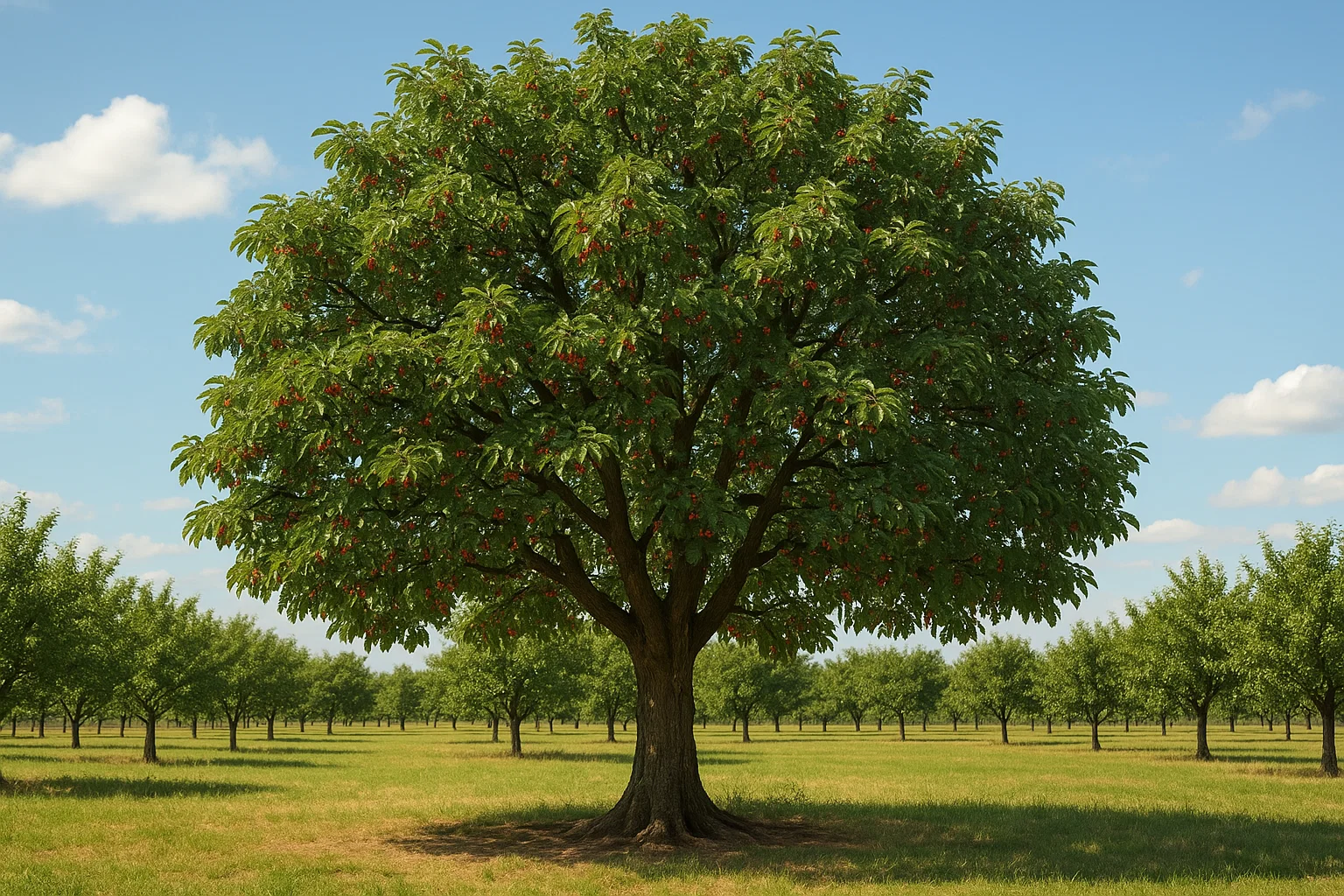
🌱 Dwarfing Rootstocks 🌱
Dwarfing rootstocks, such as Gisela or Colt, are perfect for smaller gardens or when you want to make harvesting cherries easier. These rootstocks produce smaller trees, usually between 6-12 feet tall, which bear fruit much earlier (in just 2-4 years). 🍒 They are also easier to manage and prune. However, dwarf trees may require more care in terms of watering and protection from wind or pests. If you’re looking for a compact tree with quick results, a dwarf rootstock is ideal!
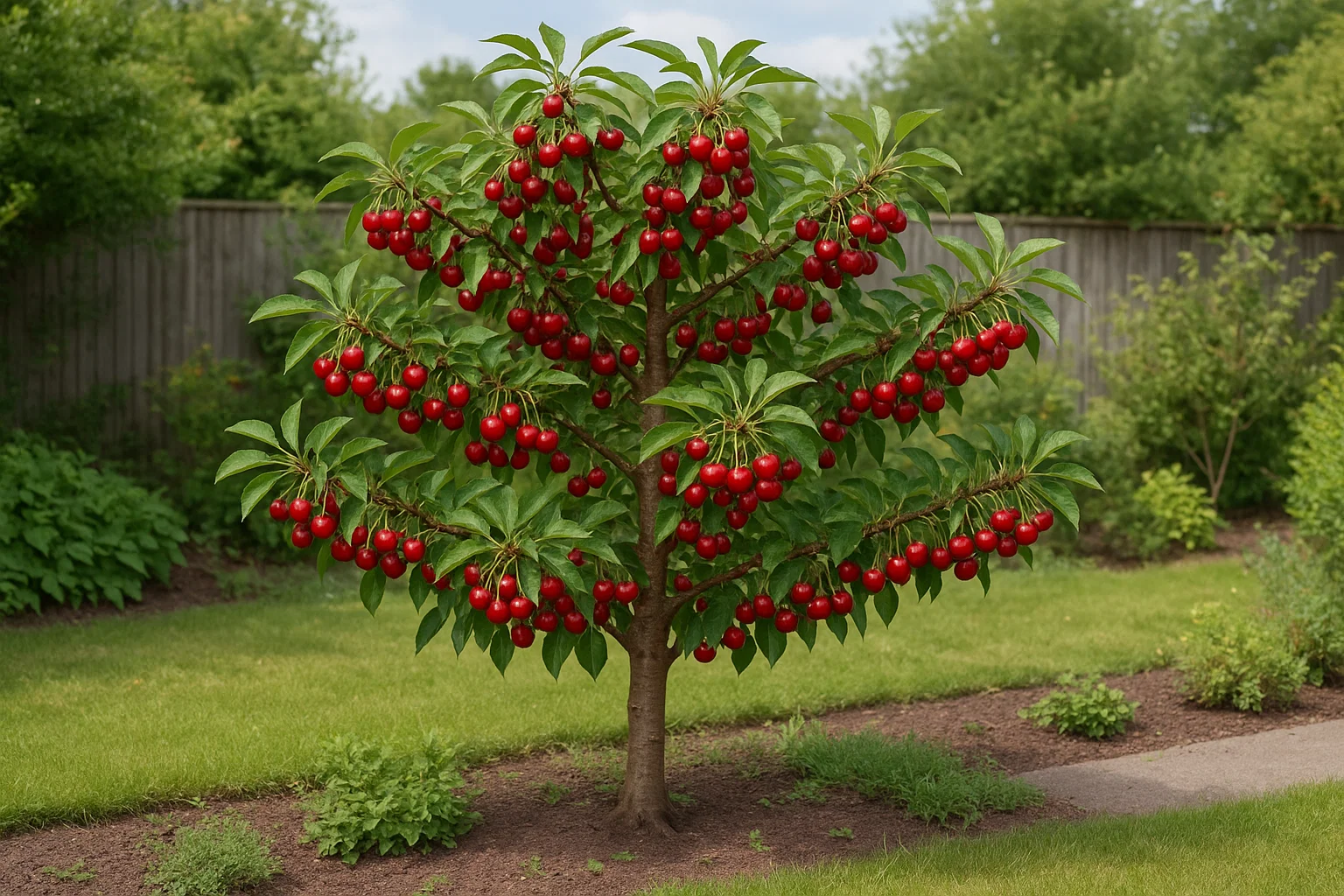
🌳✨ Semi-Dwarf Rootstocks 🌳✨
Semi-dwarf rootstocks, like Gisela 5 or Mahaleb, offer a balanced compromise. These trees grow to about 10-15 feet, providing a manageable size with a faster fruiting timeline (3-5 years). Semi-dwarfs produce high-quality fruit and are perfect for gardens where space is limited but you still want a tree with a bit more presence. 🍏 They are easier to maintain than standard rootstocks but still produce a decent-sized tree that can stand up to wind and other elements.
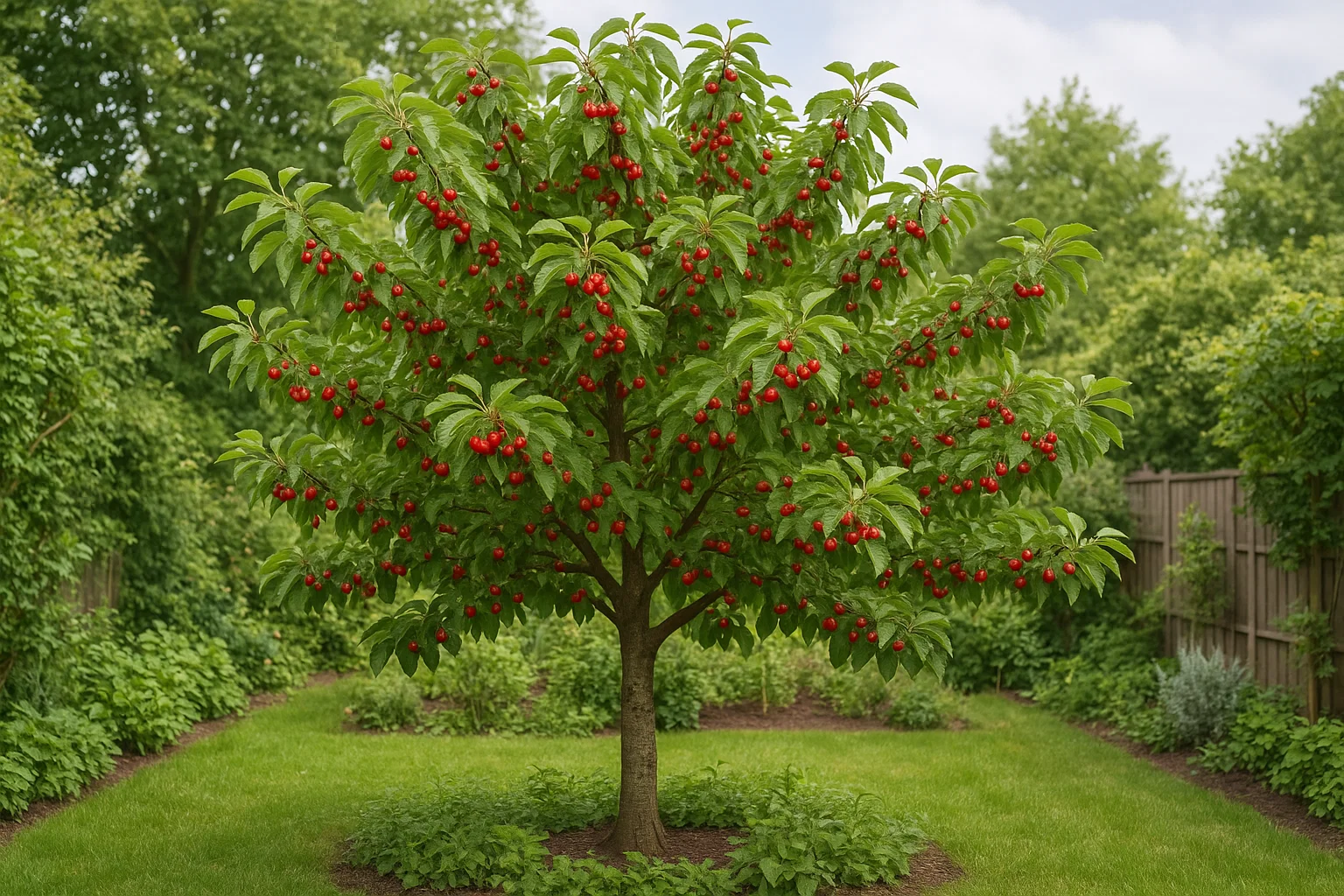
🌍 Rootstocks for Specific Conditions 🌍
Some rootstocks are designed for special conditions, such as drought resistance or tolerance to specific soil types. If you live in a region with heavy clay soil or face long periods of drought, there are rootstocks that can help your cherry tree thrive in those specific environments. 🌞🌾 Selecting the right one for your area can lead to healthier, more productive trees.
Each type of rootstock has its strengths and is suited for different needs. Understanding which one fits your garden and goals will set you up for a flourishing cherry tree! For detailed guidance on selecting the right option, refer to Cherry Tree Rootstock: Choosing the Best for Your Garden.🍒
🌞❄️ Factors to Consider When Choosing Cherry Tree Rootstock ❄️🌞
Selecting the right cherry tree rootstock goes beyond simply picking a variety. Several key factors will influence your tree’s growth, fruit yield, and overall health. Here’s what to consider when choosing the best rootstock for your garden:
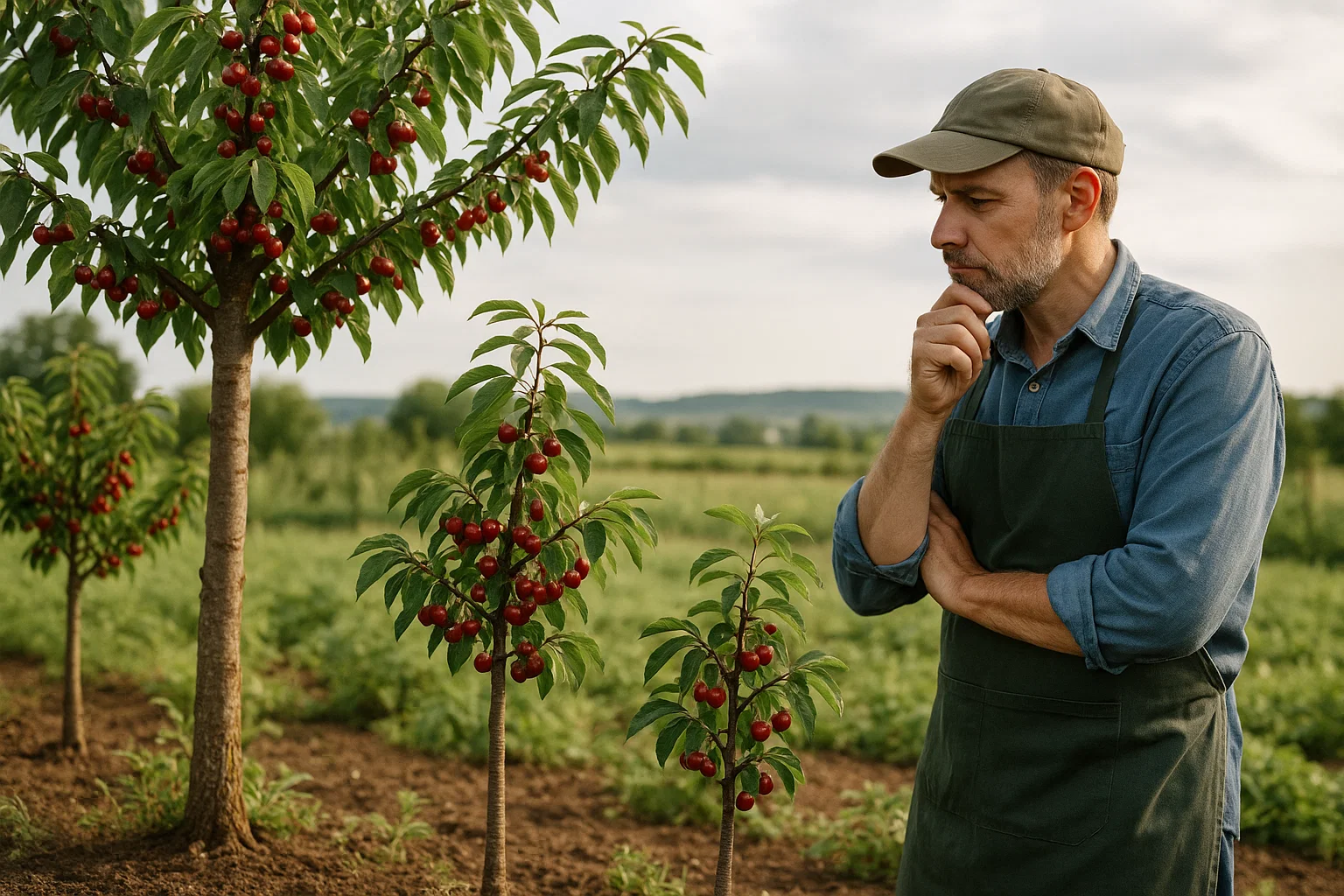
🌞❄️ Climate and Hardiness Zones 🌞❄️
Your local climate is one of the most important factors to consider. Different rootstocks thrive in different temperature ranges and hardiness zones. 🌍 If you live in a colder region, you’ll need a rootstock that can withstand frost and freezing temperatures, like Mahaleb. If you’re in a warmer climate, look for rootstocks with better heat tolerance. Knowing your USDA hardiness zone will help you select a rootstock that will survive and flourish year-round.
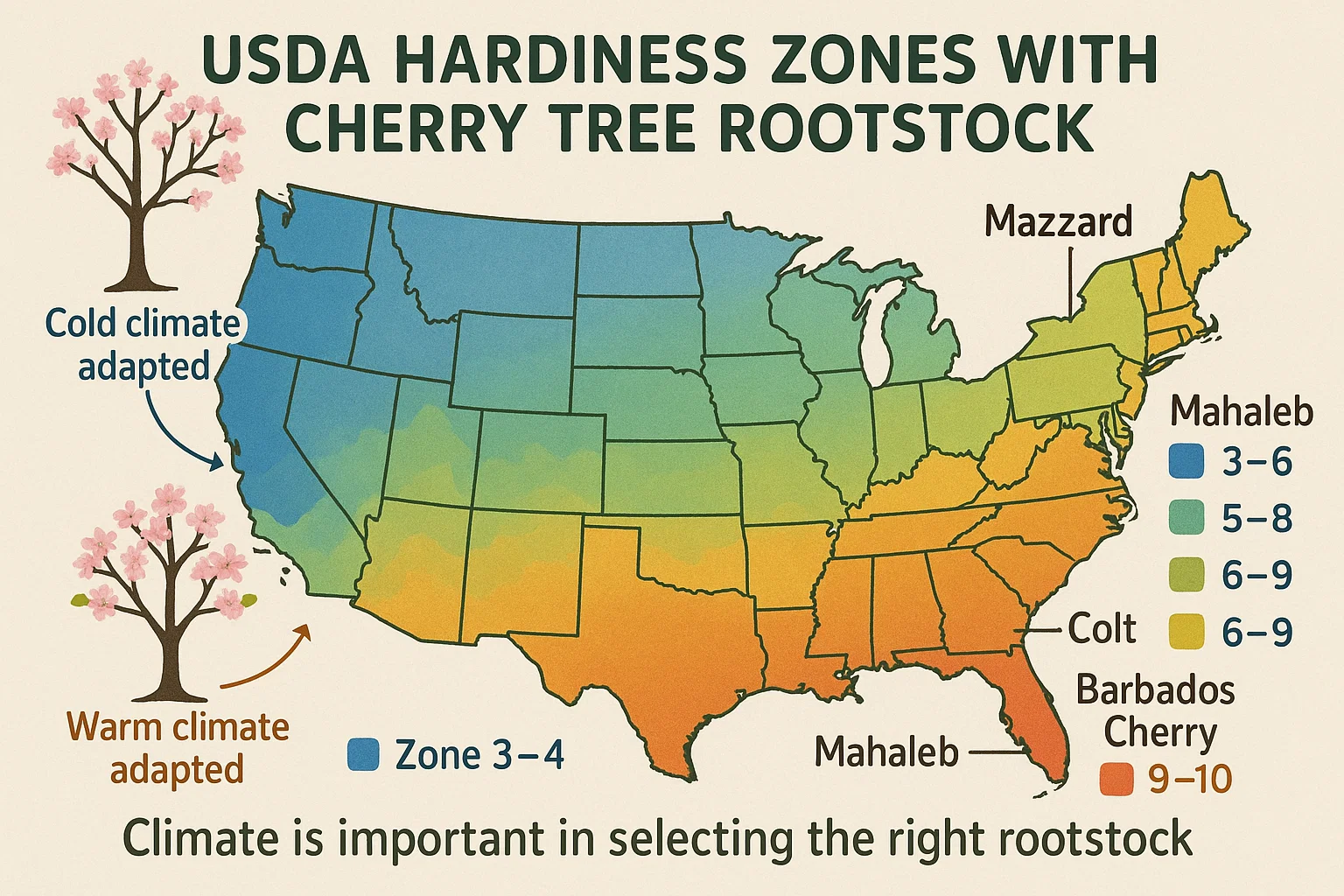
🌱🌾 Soil Conditions 🌱🌾
Cherry trees require well-drained soil, but not all rootstocks are equal when it comes to soil adaptability. Some rootstocks, like Mazzard, are more resistant to heavy, clay soils, while others, like Colt, are better suited to sandy, loamy soil. 🌿 If you have specific soil conditions, choose a rootstock that matches your soil type for optimal growth and root health. A soil test can help you determine what your garden needs.
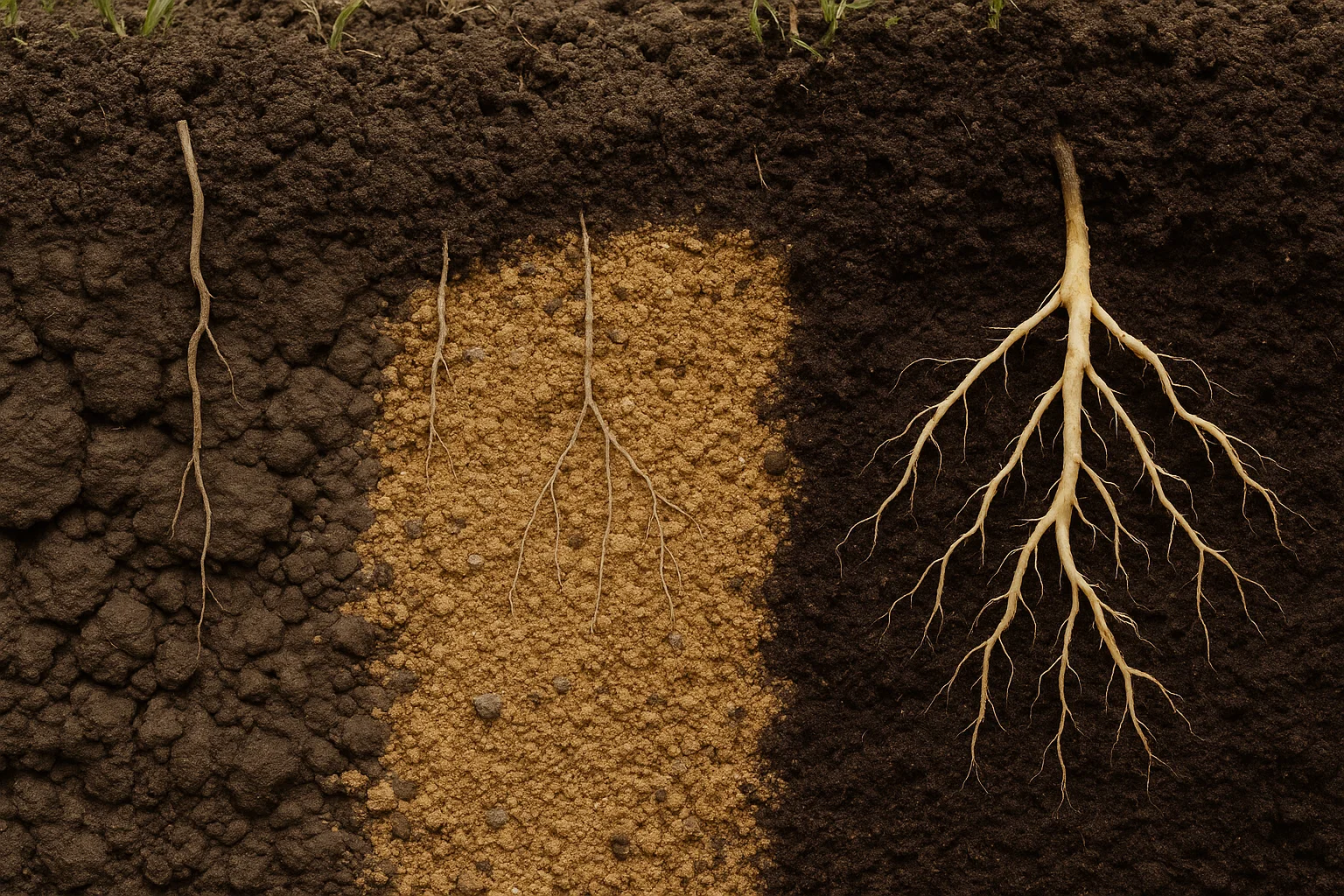
📏🌳 Tree Size and Space Considerations 📏🌳
Rootstocks determine the size of your cherry tree. Standard rootstocks create large trees, requiring more space and maintenance, while dwarf rootstocks result in smaller trees that are easier to manage and harvest. 🌱 If you’re limited on space or want to keep the tree at a manageable height, dwarf or semi-dwarf rootstocks are your best bet. But if you have a larger garden or orchard, a standard rootstock might be more suitable for long-term growth.
🍒 Desired Fruit Production and Tree Management 🍒
Think about what you want from your cherry tree: a high yield of fruit, early fruiting, or minimal tree maintenance. Dwarf rootstocks produce fruit faster (2-4 years) but may need more care. Standard rootstocks take longer to fruit (5-7 years) but tend to have more resilience and longevity. 🌳 If you’re looking for easy management and early fruit, a dwarf or semi-dwarf rootstock might be the way to go. For long-term production with minimal pruning, standard rootstocks offer great value.
By evaluating these factors, you’ll be able to choose the right cherry tree rootstock that fits both your garden and your goals. For a comprehensive guide on making the best choice, check out Cherry Tree Rootstock: Choosing the Best for Your Garden.🍒🌱
🌳📏 The Impact of Rootstock on Cherry Tree Growth and Fruit Production 🍒
The choice of rootstock has a profound impact on how your cherry tree grows and produces fruit. From tree size to yield, here’s how rootstock influences these key factors:
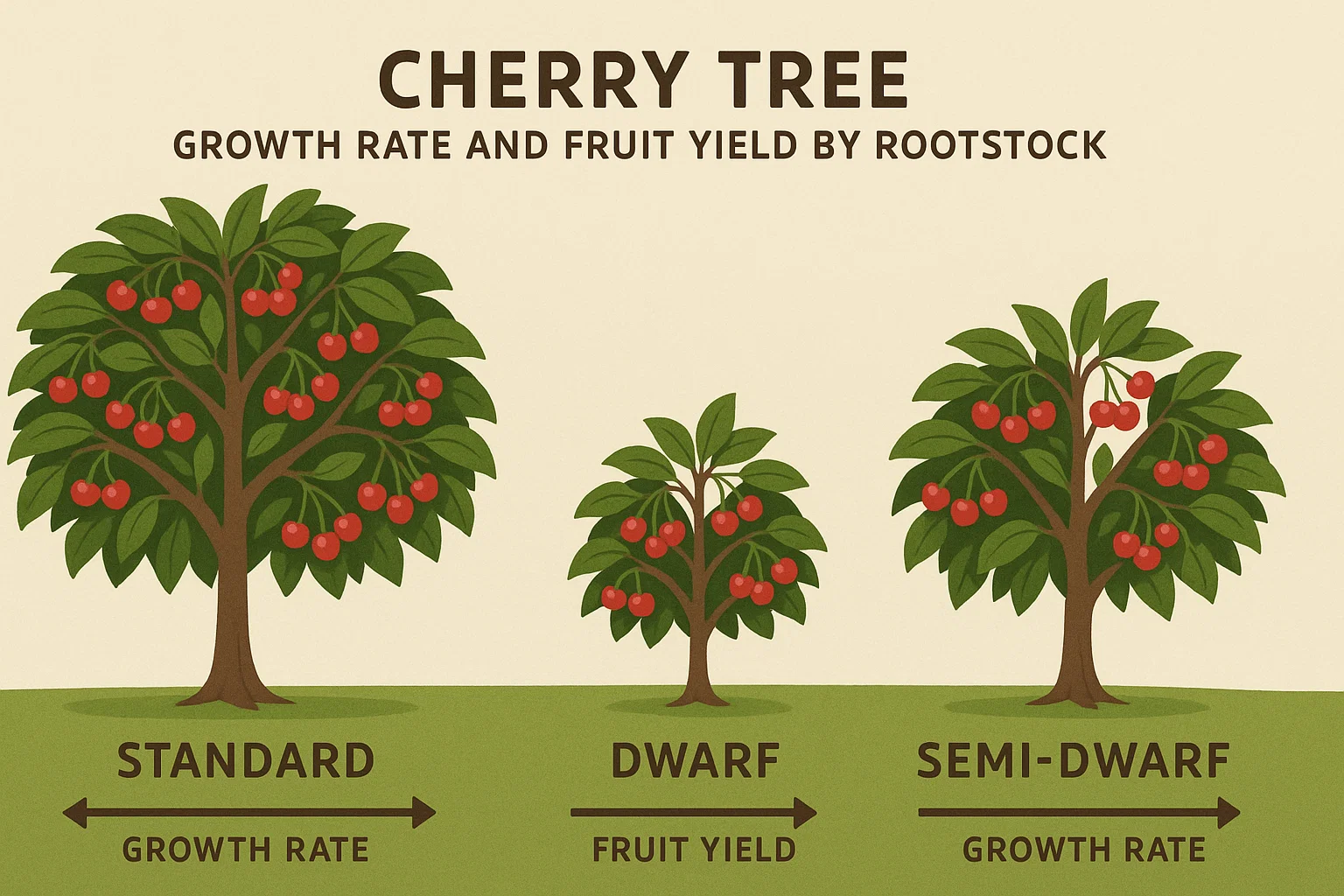
🌳📏 Growth Rate and Tree Size 📏🌳
Rootstocks play a major role in determining how fast your cherry tree grows and how large it will get.
- Standard rootstocks (e.g., Mazzard) encourage slow, steady growth, resulting in larger trees that can grow up to 20 feet tall or more. These trees take longer to mature but often have a longer lifespan. 🌱
- Dwarf rootstocks (e.g., Gisela) lead to smaller trees, typically between 6-12 feet tall. These trees grow faster and are perfect for gardeners with limited space or those who want a quicker harvest. 🌿
- Semi-dwarf rootstocks (e.g., Gisela 5) offer a balanced tree size of around 10-15 feet, providing a good mix of manageable size and quicker growth. 🌳
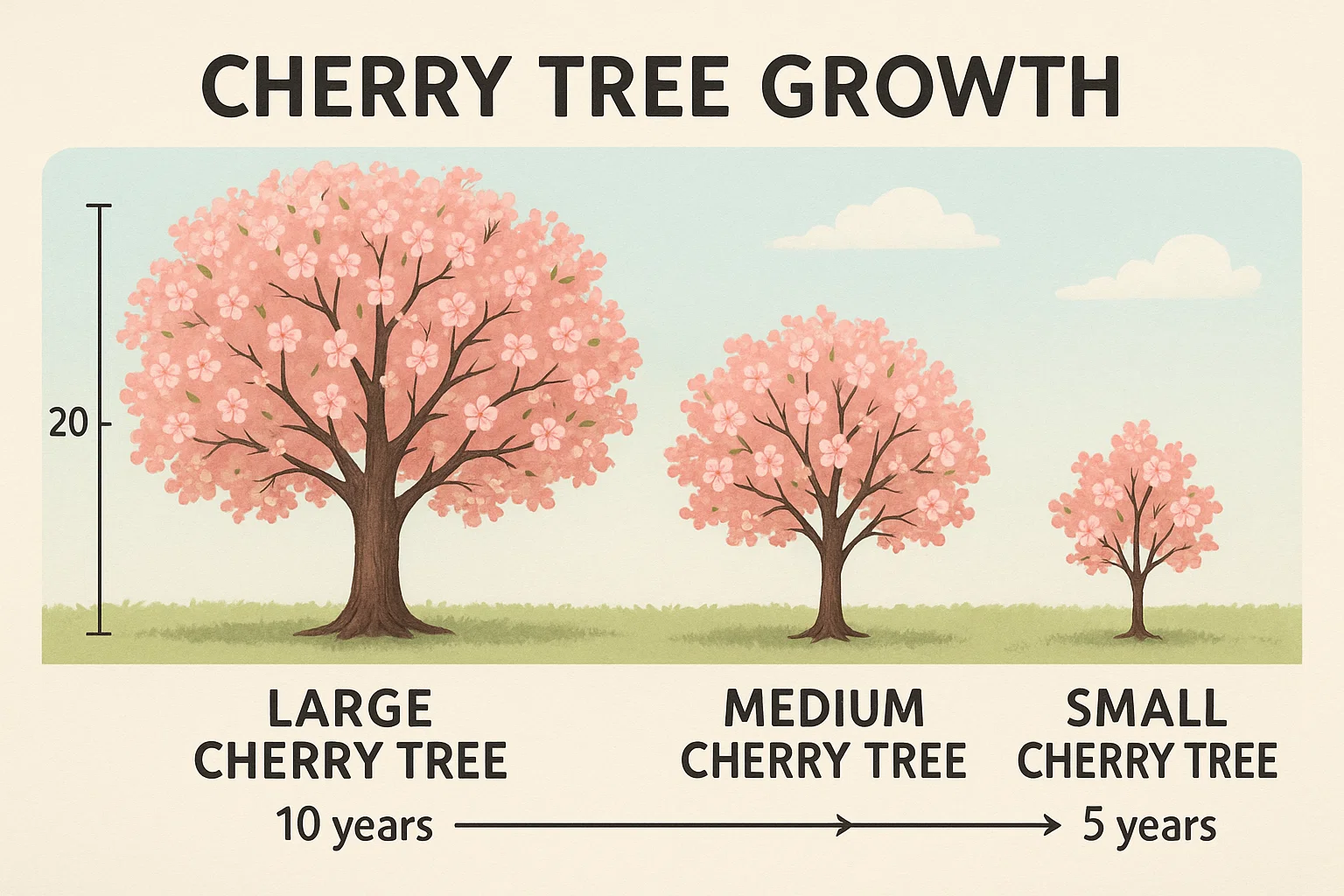
The rootstock you choose will determine how much space the tree needs and how quickly it reaches its full size.
🍒 Fruit Yield and Quality 🍒
Rootstock also influences how much fruit your tree produces and the quality of that fruit.
- Dwarfing rootstocks typically produce fewer cherries per tree, but the fruit tends to be high-quality and easy to harvest due to the tree’s smaller size. 🍏
- Standard rootstocks usually result in larger trees with higher yields. However, the fruit may take longer to ripen and require more effort for harvest. 🌿
- Semi-dwarf rootstocks strike a balance, offering decent yields with high-quality cherries. These trees tend to bear fruit more quickly than standard varieties, making them ideal for those who want both quantity and quality. 🍒
If you want quicker, high-quality cherries, dwarf or semi-dwarf rootstocks are ideal. For larger quantities of fruit, a standard rootstock may be more suited.
🌱💪 Tree Longevity and Health 💪🌱
Rootstocks impact the overall health and longevity of your cherry tree.
- Standard rootstocks are often more resilient to environmental stress and pests, ensuring your tree remains healthy for many years. 🌳
- Dwarf rootstocks may be more susceptible to diseases and pests due to their smaller root systems, which means they might need extra care and protection. 🦠
- Semi-dwarf rootstocks provide a balance, offering resilience while maintaining manageable tree size.
Rootstocks that help trees resist diseases and pests can reduce the amount of maintenance needed and extend your tree’s life. To find the most resilient options, explore Cherry Tree Rootstock: Choosing the Best for Your Garden for expert recommendations.
🌿🛠️ Maintenance and Tree Care 🛠️🌿
The rootstock also affects how much care your cherry tree requires.
- Dwarf trees are easier to manage in terms of pruning and harvesting, but they may require more attention to soil health and water supply. 🌱
- Standard trees need more space and might require more regular pruning, but they’re generally hardier and require less maintenance in terms of pest control.
- Semi-dwarf trees require moderate maintenance and are easier to manage than standard trees but still offer resilience and higher fruit production.
By choosing the right rootstock, you’ll be able to manage your tree’s care more effectively, based on the level of attention you can provide.
Ultimately, your rootstock choice has a direct influence on your tree’s growth, the quantity and quality of fruit, and how much effort goes into maintaining your cherry tree. 🍒🌱
🦠🍒 Disease Resistance and Rootstock Choice 🍒🦠
Rootstock selection can significantly impact how resistant your cherry tree is to common diseases and pests. Choosing a rootstock with the right disease resistance can save you time, effort, and money in the long run. Here’s how rootstock affects disease resistance:
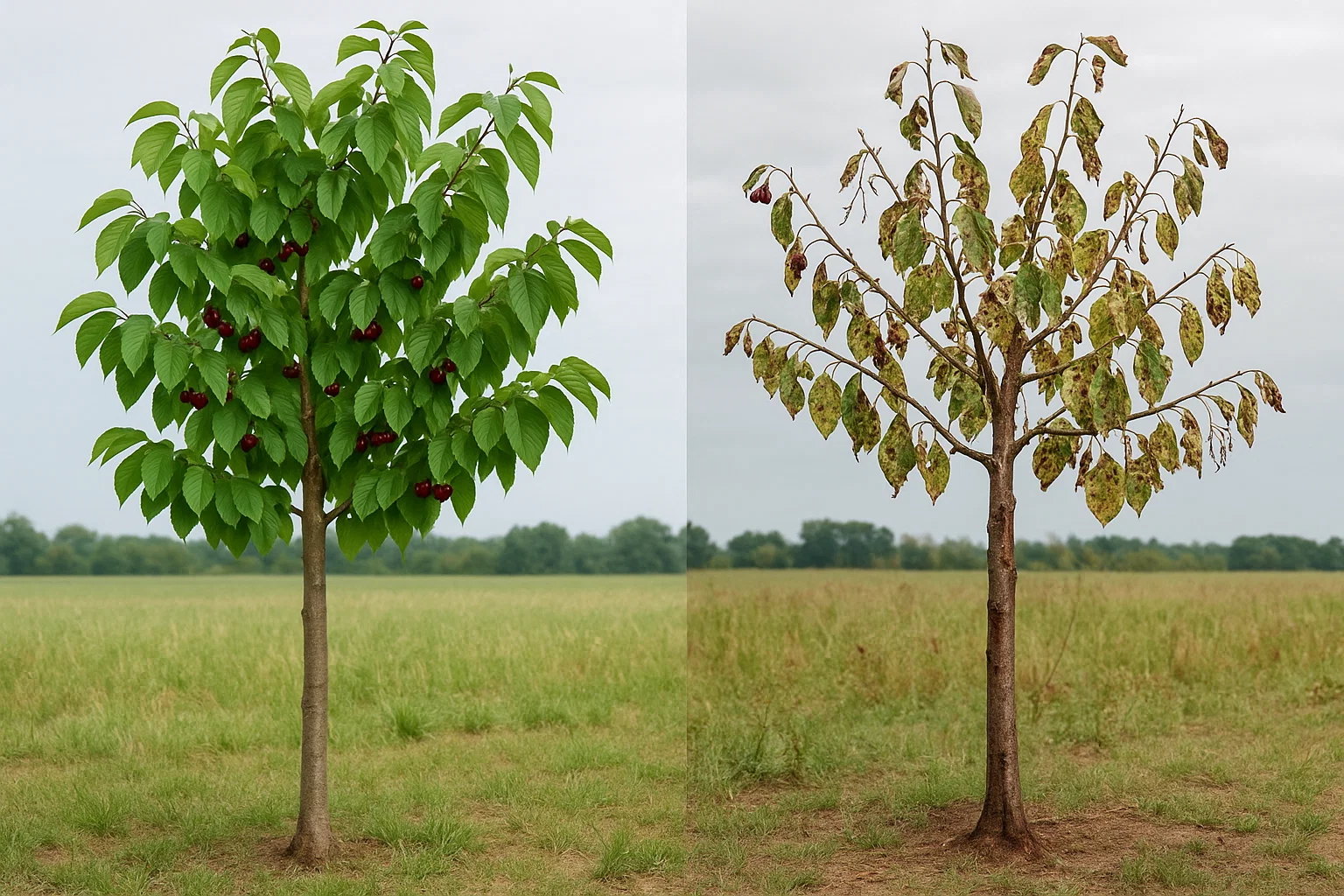
🦠🍒 Common Diseases Affecting Cherry Trees 🍒🦠
Cherry trees are vulnerable to several diseases that can affect their health and fruit production. Some of the most common include:
- Cherry Leaf Spot: A fungal disease that causes dark spots on leaves and can lead to premature leaf drop.
- Bacterial Canker: A bacterial infection that causes cankers on branches and trunk, which can severely damage the tree.
- Root Rot: Caused by poor drainage or waterlogged soils, leading to root decay and tree death.
These diseases can weaken your tree, decrease fruit yield, and shorten its lifespan. Rootstock choice plays a key role in helping your cherry tree resist these threats.
💪🌿 Rootstocks with Disease Resistance 🌿💪
Some rootstocks are specifically bred to provide resistance to certain diseases and pests. For example:
- Mahaleb Rootstock: Known for its resistance to root rot and some soil-borne diseases. This makes it a great choice for wetter areas or regions with poorly drained soil.
- Gisela Rootstocks: These rootstocks have good resistance to fungal diseases like cherry leaf spot, making them ideal for areas with high humidity or rain.
- Colt Rootstock: Offers moderate resistance to bacterial canker and is adaptable to a variety of soil conditions, making it a reliable choice for many gardeners.
Choosing a disease-resistant rootstock means your tree will need fewer treatments, reducing your reliance on pesticides and chemical sprays. This is particularly helpful if you’re growing cherries in an organic garden! 🌱
🌿✨ Rootstocks for Organic Gardening ✨🌿
For those who prefer organic gardening, selecting rootstocks with natural disease resistance is key. Rootstocks like Mahaleb and Gisela are often preferred in organic orchards because they reduce the need for chemical interventions. They help maintain healthy trees and a cleaner environment. 🌎
By choosing the right disease-resistant rootstock, you can prevent many common issues, allowing your cherry tree to grow stronger and produce healthier fruit. Learn how to make the best choice for your landscape with Cherry Tree Rootstock: Choosing the Best for Your Garden. 🍒
🌱🌳 How to Plant and Care for Cherry Trees Based on Rootstock 🌳🌱
Planting and caring for your cherry tree properly is essential for its health and productivity. The care requirements can vary depending on the rootstock you’ve chosen. Here’s how to plant and maintain your cherry tree based on its rootstock type:

🌱🌳 Planting Techniques for Different Rootstocks 🌳🌱
- Standard Rootstocks (e.g., Mazzard):
These trees grow large, so plant them in a spacious area with well-drained soil. Space them at least 20 feet apart to accommodate their size. When planting, dig a hole deep enough to allow the rootstock to sit at soil level. Make sure the graft union (where the scion meets the rootstock) is above soil level to avoid graft failure. 🌳 - Dwarf Rootstocks (e.g., Gisela):
Dwarf trees need less space, so plant them about 10-12 feet apart. Dig a hole just large enough for the roots to spread out comfortably. For dwarf varieties, ensure the graft union is at least 2 inches above the soil to prevent rotting. 🌿 - Semi-Dwarf Rootstocks (e.g., Gisela 5):
Semi-dwarf trees require moderate spacing (12-15 feet apart). Dig a hole that accommodates their root system and ensure the graft union is above soil level. These trees are typically easier to manage than standard ones, but still need room to grow.
💧🌾Watering, Fertilization, and Soil Needs 🌾💧
- Watering:
All cherry trees require consistent watering, but the amount varies based on rootstock size. Dwarf and semi-dwarf trees have smaller root systems, so they may need more frequent watering to stay hydrated, especially during dry spells. Standard rootstocks, with their larger root systems, are more drought-resistant but still need regular water during the growing season. Ensure the soil is well-drained to prevent root rot. 🌧️ - Fertilization:
Fertilize cherry trees in early spring before new growth begins. Use a balanced fertilizer that supports overall growth. Dwarf trees may need slightly less fertilizer than standard ones, as they are more compact. Always follow the recommended dosage to avoid over-fertilizing, which can harm the tree. 🌿 - Soil:
Cherry trees prefer slightly acidic, well-drained soil. If you have clay or heavy soil, consider amending it with organic matter to improve drainage. Rootstocks like Mahaleb and Colt are more adaptable to different soil types, while others may need specific conditions.
✂️🌳Pruning and Tree Training 🌳✂️
- Pruning:
Pruning is essential to keep your tree healthy, but the approach can differ based on rootstock type. For dwarf trees, prune lightly to maintain their shape and size, ensuring they stay manageable. Standard trees need more extensive pruning to remove dead or diseased wood and encourage strong, healthy branches. Semi-dwarf trees need moderate pruning to keep them balanced and productive. - Training:
For all types, consider training your tree to a central leader or open-center form. This helps maximize light exposure and promotes healthy growth. Dwarf and semi-dwarf trees are easier to train due to their manageable size, while standard trees may require more effort.
🦠🛡️Protecting Against Pests and Diseases 🦠🛡️
Dwarf Rootstocks are more vulnerable to pests like aphids or spider mites, so monitor them regularly for signs of infestations. Use organic pest control methods or insecticidal soap as needed.
Standard Rootstocks are more resistant to pests and diseases but can still fall prey to issues like fungal infections. Maintain good tree health through proper watering and pruning to reduce disease risk.
Semi-Dwarf Trees offer a balance of pest resistance and vulnerability. Regular monitoring and preventative treatments, like copper fungicide, can help protect them.
🌳🔩 Tree Support and Staking 🔩🌳
Dwarf trees are more susceptible to wind damage due to their smaller size and lighter structure. Stake them securely until they are established, but avoid tying the stake too tightly to prevent damage to the trunk.
Standard trees generally do not need staking unless in windy areas. If staking is necessary, ensure it’s temporary and not restricting the tree’s growth.
Semi-dwarf trees usually need light staking in their early years to help with stability, but they typically establish strong enough trunks as they mature.
By tailoring your care to the rootstock, you’ll set your cherry tree up for success. From planting techniques to pest management, the right attention ensures healthy, productive trees for years to come! To start with the best foundation, explore Cherry Tree Rootstock: Choosing the Best for Your Garden for guidance on selecting the ideal rootstock for your needs.🍒🌱
🌱🍒 Troubleshooting Common Issues with Rootstock Selection 🍒🌱
While selecting the right rootstock is key to a successful cherry tree, sometimes issues can still arise. Here are some common problems gardeners face when choosing rootstock and how to troubleshoot them:
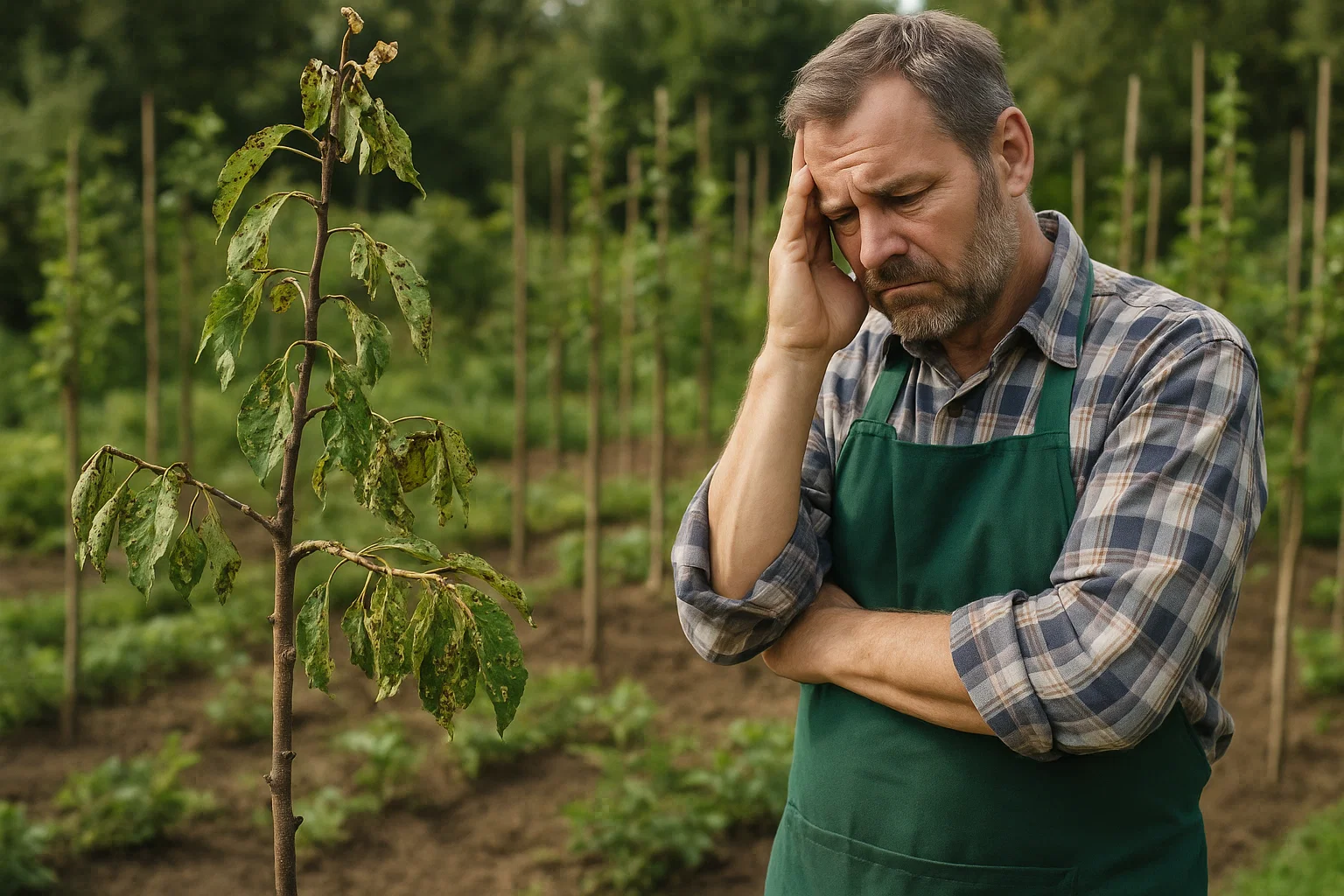
🌱🚫 Why Your Tree Isn’t Growing Well 🚫🌱
If your cherry tree is struggling to grow, the rootstock might be the issue. Here are a few possible causes:
- Incorrect Rootstock for Climate or Soil: If your rootstock isn’t suited to your climate or soil type, it could stunt growth. For example, a rootstock like Mazzard may thrive in certain soils but fail in heavy clay, while a Colt rootstock might do better in well-drained, loamy soil.
- Solution: Ensure your rootstock choice matches your garden’s soil and climate. If you’re in doubt, consult a local nursery for advice on rootstocks that work best in your area.
- Graft Failure: The graft union (where the rootstock meets the scion) might fail, causing poor tree growth or death. This can happen if the graft wasn’t done properly or if the rootstock isn’t compatible with the scion.
- Solution: Check that the graft union is above soil level and that the graft was done correctly. If the union is buried, it may cause rotting. If graft failure occurs, you might need to re-graft or start with a new tree.
🍒🚫 Poor Fruit Production 🚫🍒
If your cherry tree is not producing as much fruit as expected, there could be several reasons related to the rootstock:
- Rootstock Growth vs. Fruiting Balance: Some rootstocks, especially standard rootstocks like Mazzard, result in a vigorous tree that takes longer to fruit (often 5-7 years). Dwarf rootstocks, like Gisela, fruit more quickly but may yield less.
- Solution: Consider whether you’re expecting early fruiting from a standard rootstock. If quick fruiting is important, switch to a semi-dwarf or dwarf rootstock for faster yields.
- Overcrowding or Poor Spacing: Trees planted too close together may struggle to produce fruit because they’re competing for light and nutrients.
- Solution: Ensure your trees are spaced properly based on their rootstock size. Standard trees require more space, while dwarf trees can be planted closer together.
🌿⚡Rootstock Compatibility Problems ⚡🌿
Sometimes, rootstock and scion incompatibility can lead to poor tree health and growth. This issue typically arises when a rootstock doesn’t support the scion variety properly.
- Poor Graft Compatibility: If the rootstock and scion are not a good match, it can cause weak growth, graft failure, or poor fruiting.
- Solution: Make sure you are choosing a rootstock that is compatible with the scion variety (cherry tree variety) you’re grafting. Check with your nursery or grafting expert to ensure compatibility.
- Rootstock-Specific Weaknesses: Some rootstocks might be prone to specific issues. For example, dwarf rootstocks may have smaller root systems and might not handle drought or wind as well.
- Solution: If your tree is struggling with external factors like wind or drought, consider a more robust rootstock, like Mazzard or Colt, which can handle these stresses better.
🦠⚠️ Pests and Diseases Linked to Rootstock Choices ⚠️🦠
Rootstock can also influence the tree’s vulnerability to pests and diseases. Some rootstocks are more resistant, while others may leave your tree susceptible.
- Pest Sensitivity: Dwarf rootstocks, with their smaller root systems, may be more vulnerable to root pests like nematodes or aphids.
- Solution: If pests are a problem, consider a rootstock that offers pest resistance, such as Colt or Mahaleb. You can also apply organic pest treatments to manage pest pressure.
- Disease Resistance: Some rootstocks are more prone to soil-borne diseases or fungal infections. For example, root rot may affect dwarf rootstocks more than standard ones.
- Solution: Choose disease-resistant rootstocks for areas prone to specific issues, like fungal diseases or root rot. Rootstocks like Mahaleb and Gisela offer better resistance to common cherry tree diseases.
⏳📈 Growth Rate Too Slow or Too Fast 📈⏳
Sometimes the growth rate of your cherry tree doesn’t match expectations, either growing too slowly or too rapidly.
- Slow Growth: If your tree isn’t growing as expected, it could be due to nutrient deficiencies or poor soil conditions, or the tree may be on a rootstock that is too slow-growing.
- Solution: Ensure that the soil is properly amended and that the tree is receiving enough water and nutrients. If you want faster growth, consider switching to a faster-growing rootstock, like Gisela, for dwarf trees.
- Fast Growth with Poor Structure: On the other hand, rapid growth may lead to weak trees that are more prone to breaking or becoming too large to manage.
- Solution: Consider a semi-dwarf or standard rootstock that produces a more balanced growth rate with stronger structural integrity.
By being aware of these common issues, you can troubleshoot and make adjustments to ensure your cherry tree thrives.
Whether it’s a question of rootstock compatibility, fruit production, or disease resistance, the right solutions will help you grow healthy, productive cherry trees! 🍒🌳 For expert tips on making the best rootstock decisions, explore Cherry Tree Rootstock: Choosing the Best for Your Garden.
🌟 Final Thoughts 🌟
Choosing the right rootstock is key to the success of your cherry tree, influencing its growth, fruit production, and resilience to pests and diseases. 🌱🍒 By being aware of common issues and taking the necessary steps to troubleshoot them, you can ensure that your tree remains healthy and productive for many years to come.

From selecting the right rootstock for your climate and soil to maintaining proper care, your cherry tree will flourish with the right attention and care. For expert advice on making the right rootstock choice, explore Cherry Tree Rootstock: Choosing the Best for Your Garden.🌳 With the right rootstock and a little dedication, you’ll be rewarded with delicious fruit and a thriving, strong tree! 🍒🌟
Frequently Asked Questions (FAQ)
What is Cherry Tree Rootstock?
Cherry tree rootstock refers to the root system and lower trunk of a cherry tree that supports the scion (the upper part of the tree). The rootstock determines the tree’s size, vigor, and disease resistance.
Why is choosing the right Cherry Tree Rootstock important?
Selecting the best rootstock for your cherry tree is crucial for controlling its size, ensuring optimal growth, improving fruit quality, and enhancing disease resistance.
How does rootstock affect the growth of a cherry tree?
Rootstock influences the tree’s growth rate, size, and how well it adapts to different soil conditions. It also affects fruit yield and tree longevity.
What are the different types of Cherry Tree Rootstock?
Common types of cherry tree rootstocks include standard, semi-dwarf, and dwarf rootstocks. Each has its unique benefits, such as controlling tree size or improving disease resistance.
What is the best rootstock for a small garden?
For small gardens, semi-dwarf or dwarf rootstocks are ideal as they produce compact trees that are easier to manage and harvest.
Can I grow a cherry tree on my own rootstock?
While it’s possible to grow a cherry tree on its own rootstock, grafting onto a different rootstock is often preferred for better control over size, fruit production, and resistance to disease.
Item #7aHow do I choose the best Cherry Tree Rootstock for my soil?
Consider the soil type and climate of your garden when selecting rootstock. For example, some rootstocks are better suited for heavy clay soils, while others thrive in well-drained soils.
Does the Cherry Tree Rootstock affect fruiting?
Yes, the rootstock can affect the timing and quality of fruiting. Rootstocks that are more vigorous may produce more fruit, but less productive rootstocks can help enhance fruit quality.
